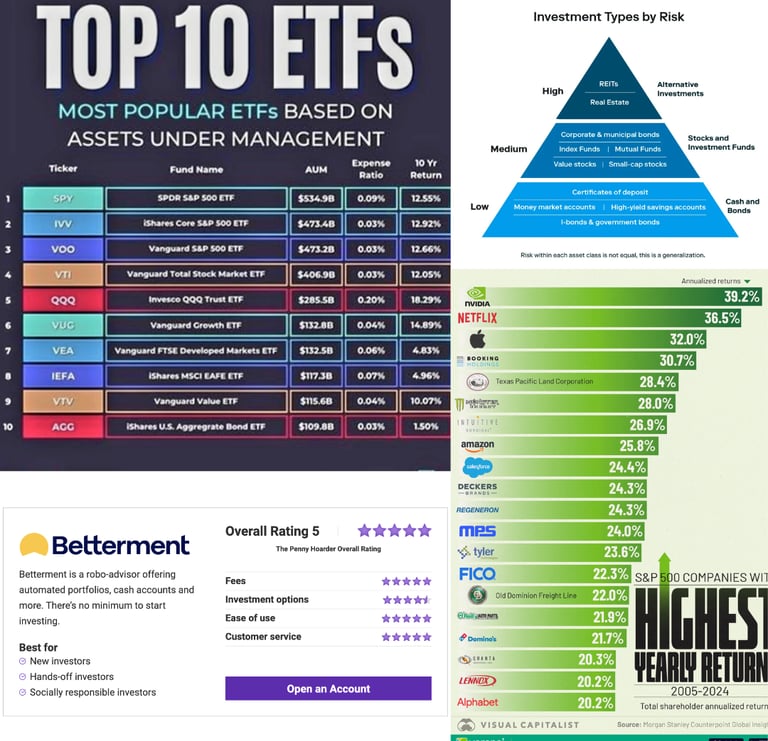Investing
What to Invest in
Over 60% of American households are now dipping their toes into the investment pool, whether directly by owning stocks or indirectly through investment funds. But let's be real—navigating the investing landscape can feel a bit like wandering through a dense jungle of jargon and unfamiliar concepts. The silver lining? You don’t need to be a math wizard or a Wall Street guru to succeed! It all starts with grasping the fundamental components of investing—these are your asset classes—and understanding how they fit into your financial puzzle. From the comforting security of a savings account to the exhilarating growth potential offered by stocks, each asset comes with its own unique mix of risks and rewards. By knowing where these various assets lie on the investment risk scale, you'll establish a rock-solid foundation to kickstart your investing journey. Let’s dive in! IN OUR OPINION
CASH - Low Risk - Wealthfront, Betterment
BONDS - Low/Medium Risk - US Treasuries
MUTUAL BONS - Medium Risk - Do your research on depending on your retirement goals
EFT - Medium/High Risk - VOO, SPLG, QQQ, QQQM, SCHD
STOCKS - High Risk - The 7% rule: sell a stock if it drops 7% below the original purchase price. Example: If you buy a stock for $100 per share, the 7% rule suggests selling it if the price drops to $93.




Retirement
When it comes to planning for retirement, one of the first things that pops up is income planning. Can you envision enjoying the lifestyle you dream of with the financial resources you have? The truth is, there’s no magical investment or foolproof strategy out there. Risk is an unavoidable part of life; it’s something we all face—even when it comes to planning our exit from this world.
We believe in a philosophy: 3 TOP RULES—first, health is paramount, followed closely by family, and then success that leads to financial freedom. Without good health, the joys of retirement fade, no matter how much money you have. Here are some delightful income strategies to consider as you craft your retirement plan. Remember, sometimes blending various approaches can help you reduce risk while enjoying the journey.
1. Encore Career: Did you know that 28% of retirees report feelings of depression? Whether or not you need the extra cash, an encore career—often seen as a second act—can provide not only a financial boost but also emotional fulfillment as you transition into retirement. So why not help people to sail into the sunset with a sense of purpose?
2. Real Estate Income: Three popular real estate investment avenues include: self-managed investment properties, privately traded real estate investment trusts (REITs), and Delaware statutory trusts. Benefit: These options can offer valuable cash flow while they appreciate over time, adding a lovely touch to your income strategy.
3. Dividends: A classic approach to retirement income is the dividend portfolio. This strategy entails purchasing shares from companies known for offering consistent and competitive dividends. The goal? To preserve your principal while enjoying the income generated from dividends. Benefit: You not only stand to gain from dividend payments but also from potential growth in your investments.
2025 FindmeQuik© All rights reserved
We'd love to hear from you! Share your travel tips, questions, or feedback about our blog.
